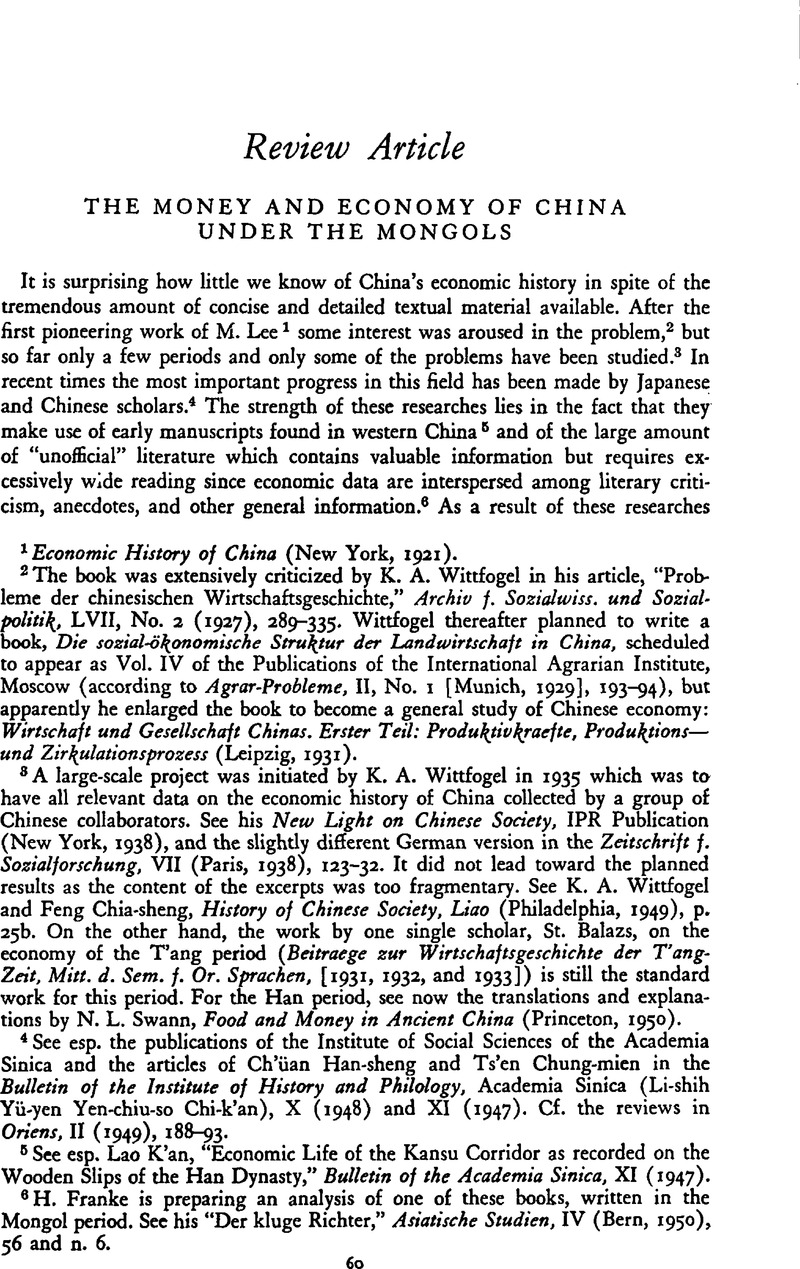No CrossRef data available.
Published online by Cambridge University Press: 03 February 2011

1 Economic History of China (New York, 1921).Google Scholar
2 The book was extensively criticized by Wittfogel, K. A. in his article, “Probleme der chinesischen Wirtschaftsgeschichte,” Archiv f. Sozialwiss. und Sozialpolitik, LVII, No. 2 (1927), 289–335Google Scholar. Wittfogel thereafter planned to write a book, Die sozial-ökonomische Struktur der Landwirtschaft in China, scheduled to appear as Vol. IV of the Publications of the International Agrarian Institute, Moscow (according to Agrar-Probleme, II, No. 1 [Munich, 1929], 193–94)Google Scholar, but apparently he enlarged the book to become a general study of Chinese economy: Wirtschaft und Gesellschaft Chinas. Erster Teil: Produktivkraefte, Produktions— und Zirkulationsprozess (Leipzig, 1931).Google Scholar
3 A large-scale project was initiated by K. A. Wittfogel in 1935 which was to have all relevant data on the economic history of China collected by a group of Chinese collaborators. See his New Light on Chinese Society, IPR Publication (New York, 1938)Google Scholar, and the slightly different German version in the Zeitschrift f. Sozialforschung, VII (Paris, 1938), 123–32Google Scholar. It did not lead toward the planned results as the content of the excerpts was too fragmentary. See Wittfogel, K. A. and Chia-sheng, Feng, History of Chinese Society, Liao (Philadelphia, 1949), p. 25bGoogle Scholar. On the other hand, the work by one single scholar, St. Balazs, on the economy of the Tʼang period (Beitraege zur Wirtschaftsgeschichte der Tʼang-Zeit, Mitt. d. Sent. f. Or. Sprachen, [1931, 1932, and 1933]) is still the standard work for this period. For the Han period, see now the translations and explanations by Swann, N. L., Food and Money in Ancient China (Princeton, 1950).Google Scholar
4 See esp. the publications of the Institute of Social Sciences of the Academia Sinica and the articles of Chʼüan Han-sheng and Tsʼen Chung-mien in the Bulletin of the Institute of History and Philology, Academia Sinica (Li-shih Yü-yen Yen-chiu-so Chi-kʼan), X (1948) and XI (1947). Cf. the reviews in Oriens, II (1949), 188–93.
5 See esp. Kʼan, Lao, “Economic Life of the Kansu Corridor as recorded on the Wooden Slips of the Han Dynasty,” Bulletin of the Academia Sinica, XI (1947).Google Scholar
6 H. Franke is preparing an analysis of one of these books, written in the Mongol period. See his “Der kluge Richter,” Asiatische Studien, IV (Bern, 1950), 56 and n. 6.Google Scholar
7 Cf. the long but rather uncritical article of Bao-seing, Liao, “Die Geschichte des chinesischen Geldes,” Bulletin of the Academia Sinica (Frankfurt, 1939–1941), XIV, 239–72Google Scholar; XV, 60–105, 229–73; XVI, 54–119, 162–216.
8 An analysis of the earliest Chinese budgets is published in Tʼoung Pao, XXXVI (1942), 20–22.Google Scholar
9 The argument of K. A. Wittfogel and Feng Chia-sheng, History of Chinese Society, p. 184, that the Chʼ:i-tan made no inflation because the government did not feel threatened by a powerful class of independent businessmen whose economic strength it wanted to destroy sounds very unconvincing. [This book is reviewed in this issue of the Journal of Economic History-Editors.]
10 Cf. Liao Bao-seing, Bulletin of the Academia Sinica, XVI, 202.
11 For example, his “Sen-ge, das Leben eines uigurischen Staatsbeamten zur Zeit Chubilai's,” Bulletin of the Academia Sinica, XVII (Frankfurt, 1942), 90–113Google Scholar. See also his Die asiatischen Völkerwanderungen (Berlin-Leipzig, 1948Google Scholar, in the series Lehrhefte für den Geschichtsunterricht in der Oberschule), and his “Some Remarks on the Interpretation of Chinese Dynastic Histories,” Oriens, III (Leyden, 1950), 113–22.Google Scholar
12 Geld und Wirtschaft in China unter der Mongolen-Herrschaft: Beiträge zur Wirtschaftsgeschichte der Yüan-Zeit (Das Mongolische Weltreich. Quellen und Forschungen), III (Leipzig: Otto Harrassowitz, 1949), 171.Google Scholar
13 See Jahn, K., Archive Orientale, X (1938), 308–40Google Scholar, and Belleten No. 23/4 (Ankara, 1942), pp. 269–309.Google Scholar
14 Togan, Z. V., Umumi Turk Tarihine giris (Istanbul, 1946), p. 119.Google Scholar
15 See, for example, the data on sea trade collected in the Bulletin of Chinese Studies (Chung-kuo Wen-hua Yen-chiu Hui-kʼan), IV, Pt. 1 (September, 1944), 239 ff.Google Scholar, and V, Pt. i (September, 1945), 71 ff.